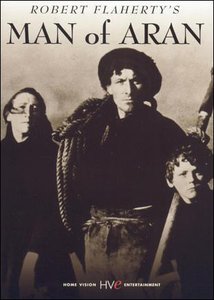Man of Aran
Man of Aran is a 1934 British fictional documentary ethnofiction film directed by Robert J. Flaherty about life on the Aran Islands off the western coast of Ireland. It portrays characters living in premodern conditions, documenting their daily routines such as fishing off high cliffs, farming potatoes where there is little soil, and hunting for huge basking sharks to get liver oil for lamps. Some situations are fabricated, such as one scene in which the shark fishermen are almost lost at sea in a sudden gale. Additionally, the family members shown are not actually related, having been chosen from among the islanders for their photogenic qualities.
The film opens with a boy crab fishing. We then observe three fishermen landing a flimsy holed curragh in the force of the wind and the huge waves. Next we see some of the hardships of mundane Aran life making a field on the barren rocks using seaweed and soil scraped out of rock crevices, fixing holes in the boat with a mixture of cloth and tar, rendering the liver of the giant basking shark. The film follows as the men of Aran harpoon the huge beasts from their bd iomartha a wooden carvel hulled craft, the film ends with another storm sequence where the distressed family on shore watch the prolonged struggle of the boat to land safely against the elements.The reputation of Man of Aran rests as much on controversies over truth and accuracy than its aesthetic achievement. Some contend that Man of Aran is more valuable as a documentary of Robert Flahertys vision of life than it is of life itself. Others see it as a betrayal of documentarys mission, to tell it like it is. And yet, according to Richard Barsam, Flaherty is one of the great innovators of the documentary formcreating a nonfiction genre all of his own. ........
Source: Wikipedia

